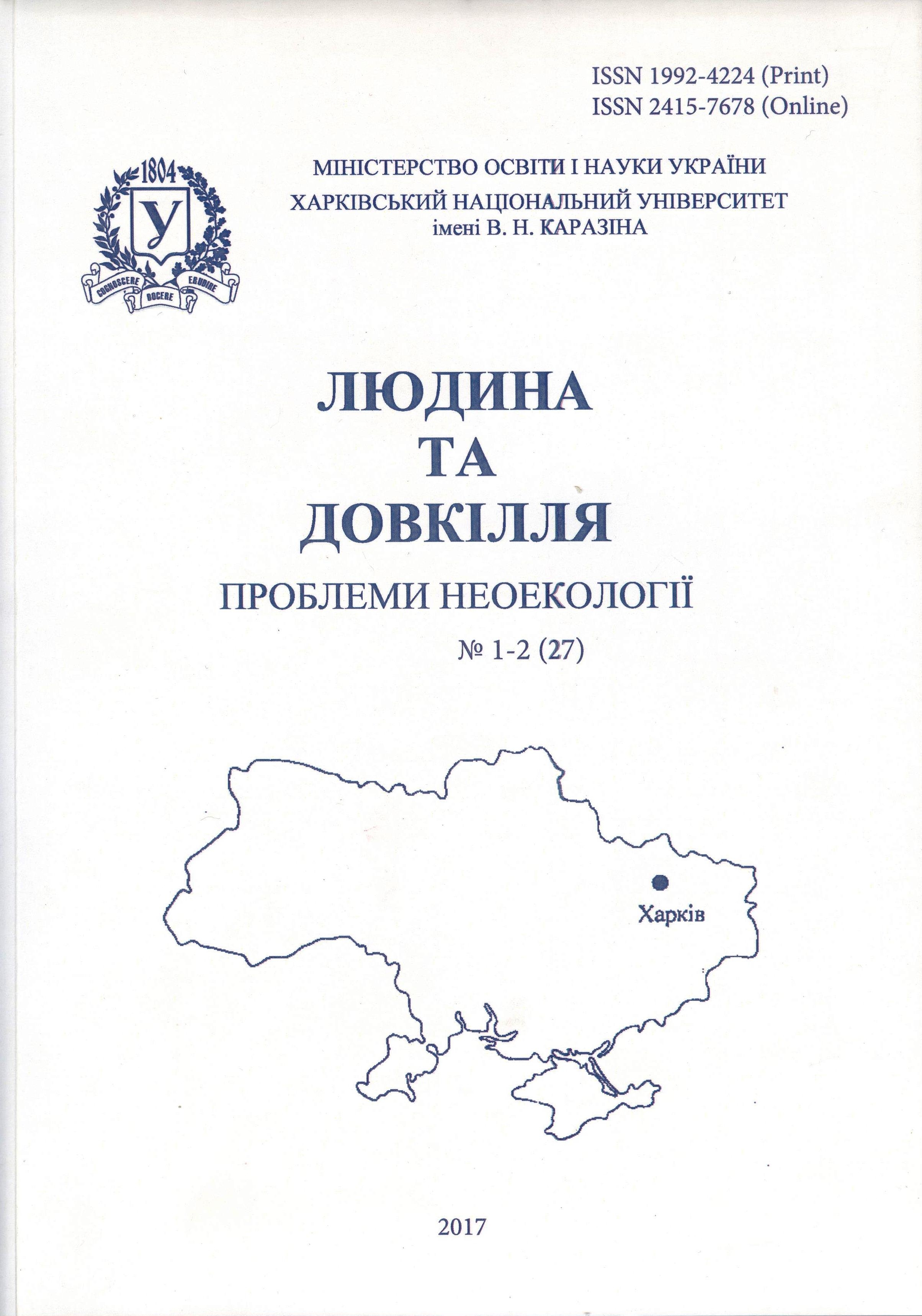Anti-Erosion Optimization of Agricultural Equipment: Local Level
Abstract
Soil erosion is a major factor in their economic and environmental degradation. Protection of land from erosion is characterized by insufficient methodological support at the local territorial level. Purpose. To reveal the advantages and disadvantages of the current state of anti-erosion design on the example of a particular agricultural enterprise. Methods. Cartographic, with application of geoinformation technologies, computational, statistical and mathematical. Results. On the example of one of the private farms of the Kharkiv region, the draw backs of the existing structure of the crops area of agricultural crops in the anti-erosion aspect are shown. It was optimized taking in to account the specialization of the economy. The soil was washed out in different scenarios of land use. The introduction of erosion-optimized crop rotation allows to reduce the forecast of soil fault in field crop rotation by 1.3 times. Conclusions. The structure of the crop area of agricultural crops, even meeting the formal requirements of normative acts, does not provide adequate protection against water erosion. It requires additional expertise using mathematical models of erosion. Minor deviations from the recommended standards of permissible flushing can be adjusted by means of agrotechnical measurеs, significant – additional organizational and agronomic measures.
Downloads
References
Bulygin, S.Yu. (2005). Formuvannya ecolohichno stalyh agrolandshaftiv. [Formation of environmentally sustainable agricultural landscapes]. K.: Urozhaу. 300. [in Ukrainian].
Kutsenko, M.V. (2014). Kompleksna prostorova optymizatsiya struktury sil’skohospodars’kyh uhid’: rehionalnyy riven’. [Integrated spatial optimization of the agricultural land structure: regional level]. Visnyk of V. N. Karazin Kharkiv national university series «Ecоlogy»,10, 99-105. [In Ukrainian].
Kutsenko, M.V., Kruglov, O.V. (2014). Gruntozahysna optymizatsiya struktury sil’skohospodars’kyh uhid’. [Soil-protective optimization of the structure of agricultural lands]. Visn. ahrarnoyi nauky, 1. 51-54. [In Ukrainian].
Timchenko, D.O., Kutsenko, M.V., Kruglov, O.V., Nazarok, P.G. (2015). Otsinyuvannya eroziynoyi ne-bezpeky gruntiv pid chas provedennya zemlevporyadnyh robit. [Estimation of soil erosion hazard during land surveying works]. Agroecological journal, 1. 59-62. [In Ukrainian].
Svetlichny, A.A., Cherny, S.G., Shvebs, G.I. (2004). Eroziovedenie: teoreticheskie I prikladnyie aspekty. [Erosiology: theoretical and applied aspects]. Sumy: The University Book. 410. [in Russian].
Kutsenko, M.V., Timchenko, D.O. (2016) Teoretychni osnovy orhanizatsiyi systemy ohorony gruntiv vid eroziyi v Ukrayini: Monohrafiya. [Theoretical Foundations of Organization of the Soil Protection System against Erosion in Ukraine: Monograph]. Kharkiv: KP “Mis’ka drukarnya”. 240. [In Ukrainian].
“Pro zatverdzhennya normatyviv optymal’noho spivvidnoshennya kul’tur u sivozminah v riznyh pryrodno- sil’skohospodars’kyh rehionah”. ["On Approval of the Norms of Optimal Ratio of Crop in Crop rotations in Various Natural-Agricultural Regions"]. Cabinet of Ministers of Ukraine Resolution dated February 11, 2010 No. 164] // The Official Bulletin of Ukraine. 13. 33 - 34. [In Ukrainian].
Pro zatverdzhennya Metodychnyh rekomendatsiy shodo rozroblennya proektiv zemleustroyu, sho zab-ezpechuyut’ ecoloho-economichne obhruntuvannya sivozminy ta vporyadkuvannya uhid’.["On Approval of Methodical Recommendations for the Development of Land Management Projects, Providing Ecological and Economic Justification for Crop rotation and Land Reconciliation"]. Order No. 396 (dated 02.10.2013), Zemlevporyadnyy visnyk, 10. 52 - 63. [In Ukrainian].
Pro vnesennya zmin do deyakyh zakonodavchyh aktiv shodo sproshennya umov vedennya biznesu (Dere-hulyatsiya). ["On Amendments to Certain Legislative Acts of Ukraine on Facilitation of Business Conditions (Deregulation)"]. The Law of Ukraine No. 191-VIII / Voice of Ukraine dated 04.04.2015, 61. [In Ukrainian].
Yakist’ gruntu.Vyznachennya potentsiynoyi zagrozy eroziyi pid vplyvom doshiv. [Quality of soil. Determination of the potential threat of erosion under the influence of rains].: DSTU 7904: 2015. [Effective from 01-07-2016]. - K .: DP UkrNDNC, 2016. 12 . (National Standard of Ukraine). [In Ukrainian].
Achasov, A., Achasova, A. (2016) Do pytannya formuvannya agrarnyh geoinformatsiynyh system. [To the issue of formation of agrarian geoinformation systems]. Visnyk of V. N. Karazin Kharkiv national university series «Ecоlogy»,14, 15-19. [In Ukrainian].
Mirtshulava, Ts.E. (1970). Inzhenernyie metody raschyota I prognoza vodnoj erozii. [Engineering methods for calculating and forecasting water erosion]. M .: Kolos. 240. [In Ukrainian].
Balakay, N.I.(2011). Otsenka intensivnosti proyavleniya erozii i pochvozaschitnoe deystvie selsko-hozyaystvennyih kultur. [Estimation of intensity of manifestation of erosion and soil protection effect of agricultural crops]. Sci. journ Kuban State Technical University, 65 (01).1-11. [in Russian].
Morgun, F.T., Shikula, N.K., Tarariko, A.G. (1983). Pochvozaschitnoe zemledelie. [Soil-protecting agriculture]. K.: Urozhaу. 240 p. [In Ukrainian].
Kutsenko, M.V. (2015) Prostorova optimizatsiya struktury sil’skohospodars’kih uhid’. [Spatial optimization of the structure of agricultural lands]. Visn. ahrarnoyi nauky, 5. 11 – 15. [In Ukrainian].
Kruglov, O.V. (2017). Matematyka proty eroziyi.[Mathematics versus erosion]. Ukrainian Farmer, 2. 74 - 76. [In Ukrainian].
Authors reserve the right of attribution for the submitted manuscript, while transferring to the Journal the right to publish the article under the Creative Commons Attribution License 4.0 International (CC BY 4.0). This license allows free distribution of the published work under the condition of proper attribution of the original authors and the initial publication source (i.e. the Journal)
Authors have the right to enter into separate agreements for additional non-exclusive distribution of the work in the form it was published in the Journal (such as publishing the article on the institutional website or as a part of a monograph), provided the original publication in this Journal is properly referenced
The Journal allows and encourages online publication of the manuscripts (such as on personal web pages), even when such a manuscript is still under editorial consideration, since it allows for a productive scientific discussion and better citation dynamics (see The Effect of Open Access).





